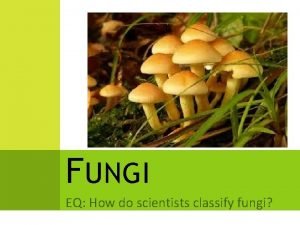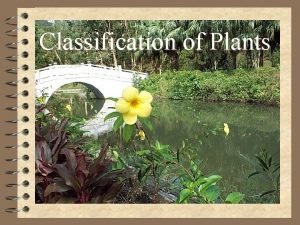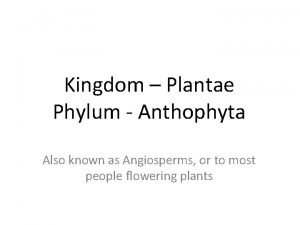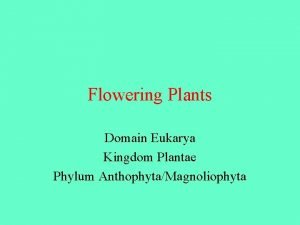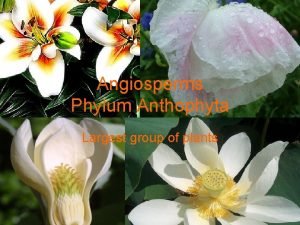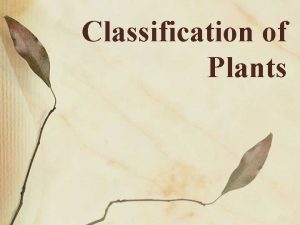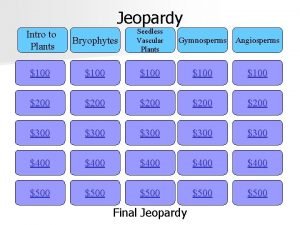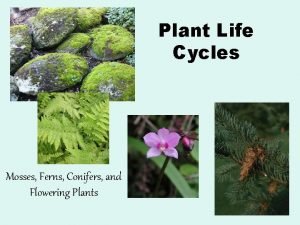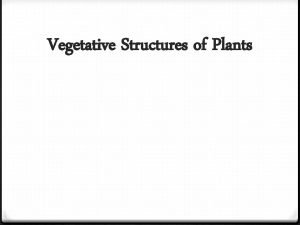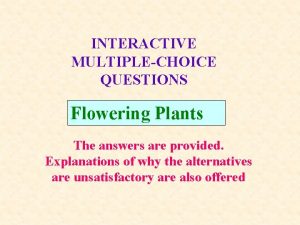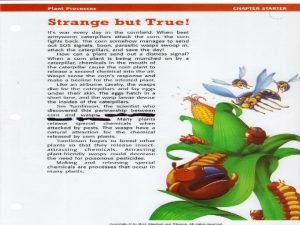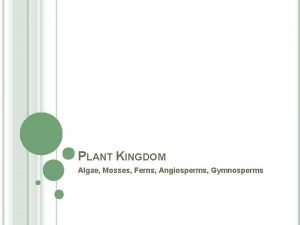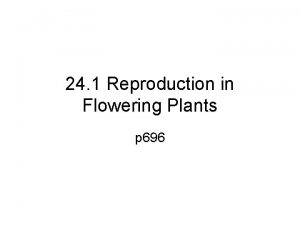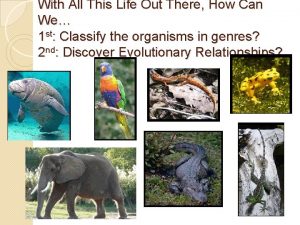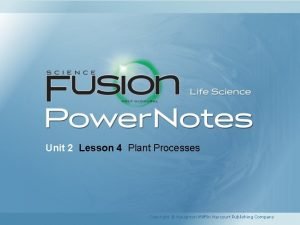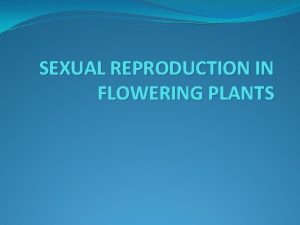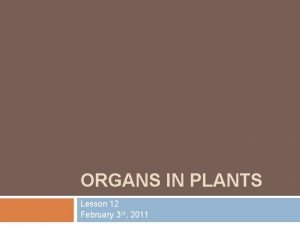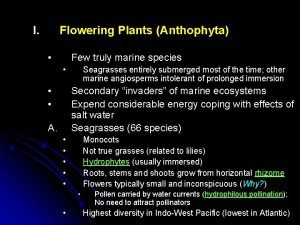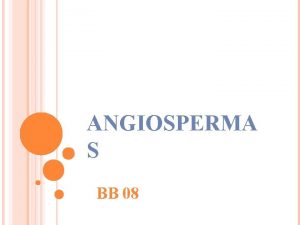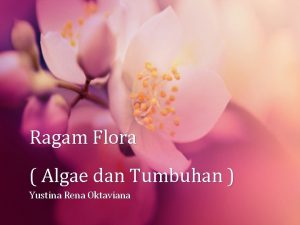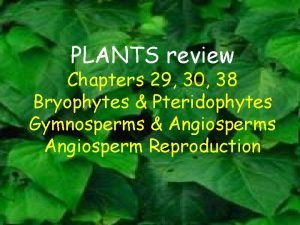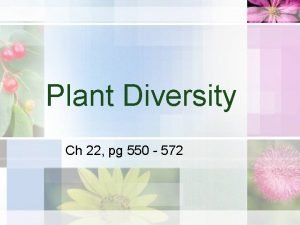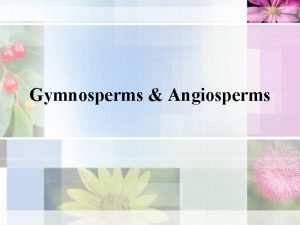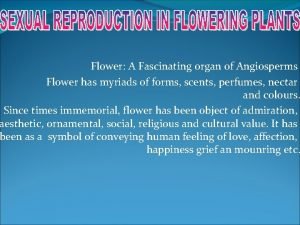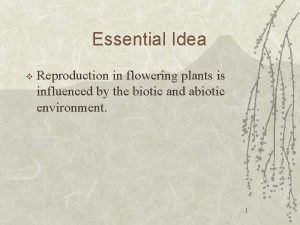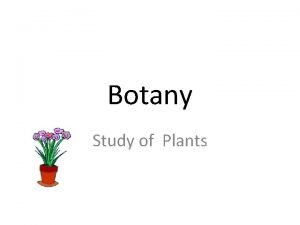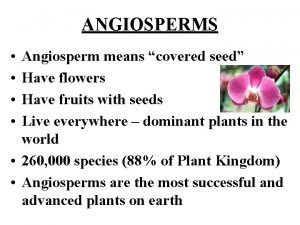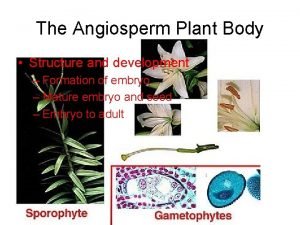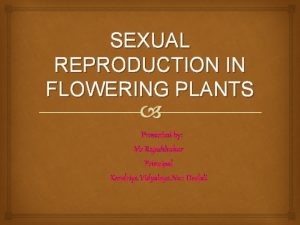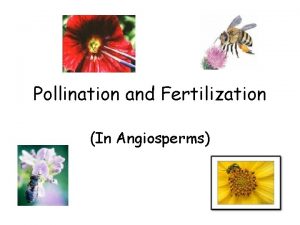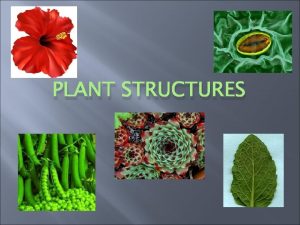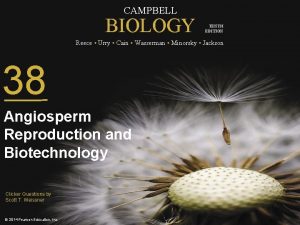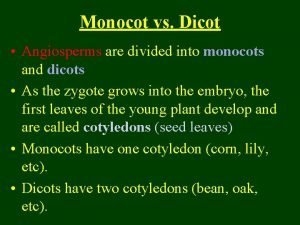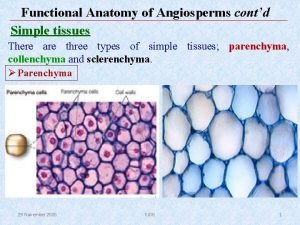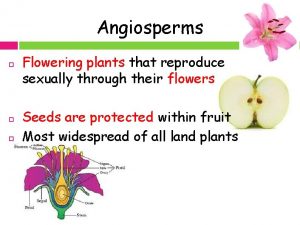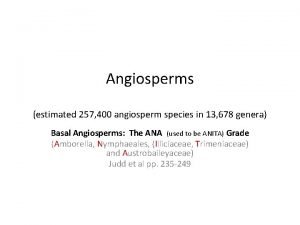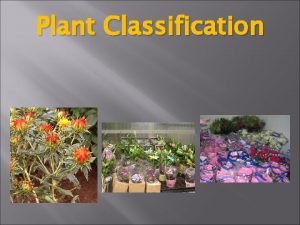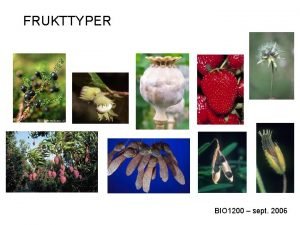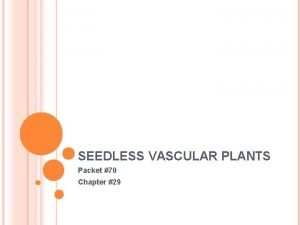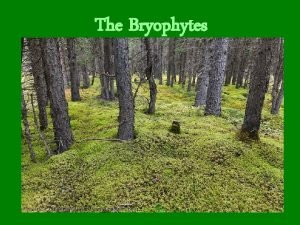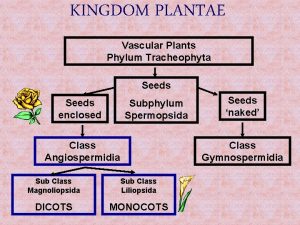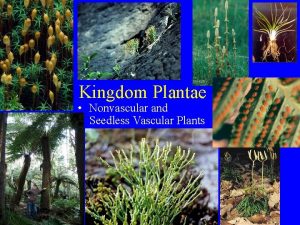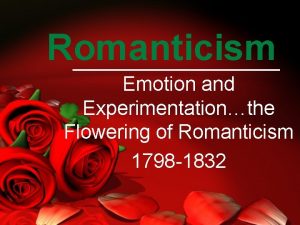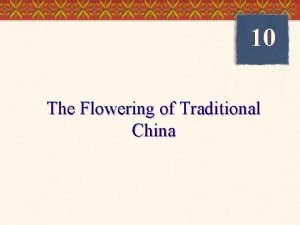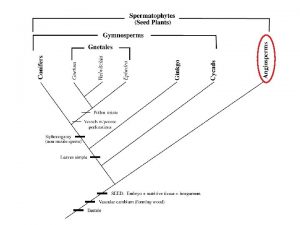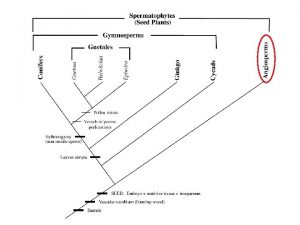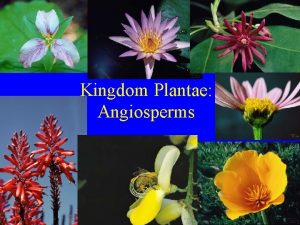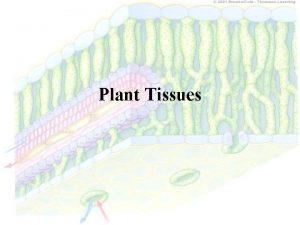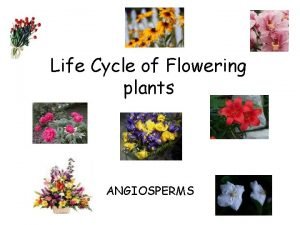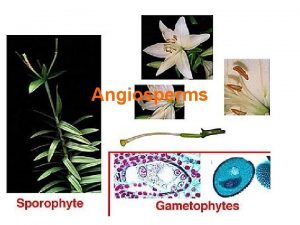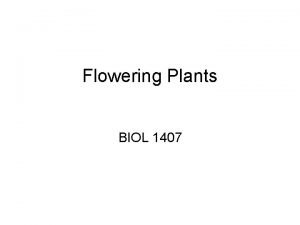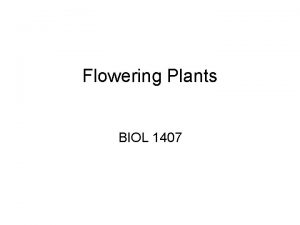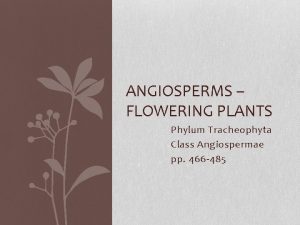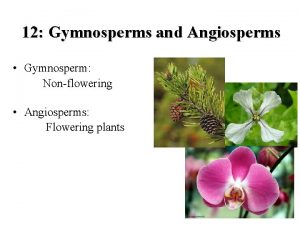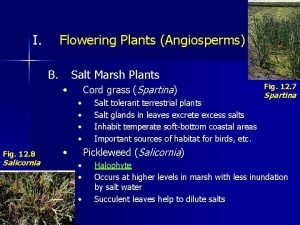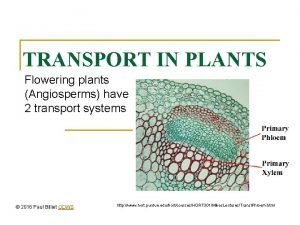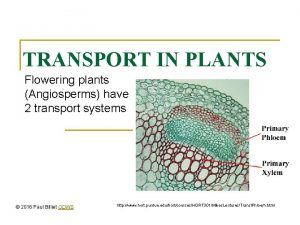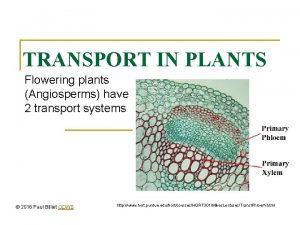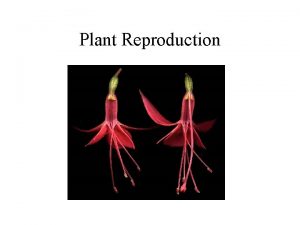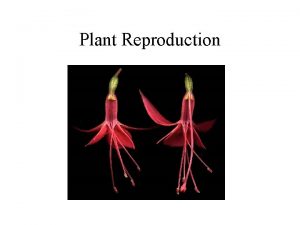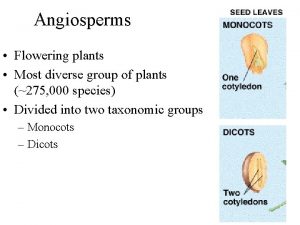Flowering Plants Chapter 25 Notes Angiosperms Phylum Anthophyta





















































- Slides: 53

Flowering Plants Chapter 25 Notes

Angiosperms • • Phylum Anthophyta Anthus “flower” phyt “plant” 300, 000+ species Earth’s Dominant Plants

Flowering Plants • Like gymnosperms: – Flowering plants have vascular tissues and produce seeds – Heterosporous – megaspores and microspores • Unlike gymnosperms: – Ovules of flowering plants are enclosed within an ovary

KEY TERMS • OVULE – Structure in the ovary that contains a female gametophyte and develops into a seed after fertilization • OVARY – Base of a carpel or fused carpels that contains ovules and develops into a fruit after fertilization

Orange Fruit Development

The Function of Fruits • Protects seeds as they grow and mature • Seed Dispersal

Flower Parts Female Parts Male Parts The Pistil – 1+ Carpels • Stigma - sticky • Style – the neck connecting stigma to ovary • Ovary – houses ovules (each contains 1 egg) The Stamen • Anther – produces pollen grains • Filament - stalk

Ecology and Economy • Our survival as a species depends on flowering plants – Major food crops • Products – Cork, rubber, tobacco, coffee, chocolate, aromatic oils for perfumes – Valuable lumber – Fibers and medicines – Clothing

Economic Botany • Subdiscipline of botany that deals with plants of economic importance – Most of these are flowering plants

KEY TERMS • COTYLEDON – The seed leaf of a plant embryo, which may contain food stored for germination

KEY TERMS • MONOCOT – Seeds contain a single cotyledon – Monocots have floral parts in threes – Monocots include grasses, orchids, irises, onions, lilies, palms • Mostly Herbaceous

KEY TERMS • EUDICOT – Seeds contain two cotyledons – Eudicots have floral parts in fours or fives – Eudicots include oaks, roses, mustards, cacti, blueberries, sunflowers

Life Cycle • Flowering plants undergo an alternation of generations: – Sporophyte generation is larger and nutritionally independent – Gametophyte generation is reduced to only a few microscopic cells

KEY TERMS • DOUBLE FERTILIZATION – A process in the flowering plant life cycle in which there are two fertilizations – One results in formation of a zygote – Second results in formation of endosperm

KEY TERMS • ENDOSPERM – The 3 n nutritive tissue formed at some point in the development of all angiosperm seeds – Formed by double fertilization • The two polar nuclei fuse with the second sperm cell

Life Cycle: Flowering Plants

Pollen Grains

Adaptations of Flowering Plants • Reproduce sexually by forming flowers • Form seeds within fruits after double fertilization • Efficient water-conducting vessel elements in xylem • Efficient carbohydrate-conducting sieve-tube elements in phloem • Have pollen grains transported by wind, water, insects, other animals

KEY TERMS • APOMIXIS – A type of reproduction – Fruits and seeds are formed asexually – No fusion of gametes – Embryo is genetically similar to parent – Plants that reproduce by apomixis: dandelions, citrus trees, blackberries, garlic, certain grasses.

Adaptability of Flowering Plants

KEY TERMS • BASAL ANGIOSPERM – Group of angiosperms thought to be ancestral to all other flowering plants • CORE ANGIOSPERM – Group including most angiosperm species – Divided into three subgroups: magnoliids, monocots, and eudicots

KEY TERMS • MAGNOLIID – One of the groups of flowering plants – Core angiosperms once classified as “dicots, ” but molecular evidence indicates they are neither eudicots nor monocots – Includes species in magnolia, laurel, and black pepper families, several related families

It’s Chart Time! Woo Hoo!

Flowering Plant Families 1 • More than 300 families • Magnolia family – Important ornamentals and source of timber – Examples: southern magnolia, tuliptree

Magnolia Family

Flowering Plant Families 2 • Walnut family – Provides nuts for food, wood for furniture – Examples: English walnut, black walnut, pecan • Cactus family – Important as ornamentals – Examples: prickly pear, Christmas cactus

Walnut Family

Fig. 25 -10 b, p. 498

Fig. 25 -10 c, p. 498

Cactus Family

Flowering Plant Families 3 • Mustard family – Many important food crops – Examples: cabbage, broccoli, cauliflower, turnip, mustard • Rose family – Commercially important fruits and ornamentals – Examples: apple, pear, plum, cherry, apricot, peach, strawberry, raspberry, rose

Mustard Family

Mustard Family

Mustard Family

Mustard Family

Rose Family

Rose Family

Rose Family

Flowering Plant Families 4 • Pea family – Important food crops – Examples: garden pea, chick pea, green bean, soybean, lima bean, peanut, red clover, alfalfa

Pea Family

Pea Family

Pea Family

Flowering Plant Families 5 • Potato family – Important food crops and chemicals used as drugs – Examples: potato, tomato, green pepper, eggplant, petunia, deadly nightshade (belladonna)

Potato Family

Flowering Plant Families 6 • Pumpkin family – Food crops – Examples: pumpkins, melons, squashes, cucumbers, cantaloupe, honeydew, muskmelon, cucumber, watermelon

Pumpkin Family

Pumpkin Family

Flowering Plant Families 7 • Sunflower family – One of the largest families of flowering plants – Examples: chrysanthemums, marigolds, sunflowers, daisies, and some food plants such as lettuce, globe artichokes

Sunflower Family

Flowering Plant Families 8 • Grass family – Most important family of flowering plants from the human standpoint – Examples: rice, wheat, corn, oats, barley, rye, sugarcane, bamboo

Grass Family

Flowering Plant Families 9 • Orchid family – One of the largest families of flowering plants; contains a greater variety of flowers than any other family – Example: the vanilla orchid • Agave family – Best known for ornamentals – Examples: century plant, sisal hemp, bowstring hemp

Orchid Family
 Classify non flowering plants with examples
Classify non flowering plants with examples Flowering and non flowering plants
Flowering and non flowering plants Non flowering plants characteristics
Non flowering plants characteristics Anthophyta
Anthophyta Lilium longiflorum
Lilium longiflorum Vertical
Vertical Phylum anthophyta examples
Phylum anthophyta examples Seedless vascular plants vs bryophytes
Seedless vascular plants vs bryophytes Conifer flowering plant
Conifer flowering plant Main part of seed
Main part of seed Multiple choice questions on flowering plants
Multiple choice questions on flowering plants Flower structure and function
Flower structure and function Parts of a leaves
Parts of a leaves Main parts of plants
Main parts of plants Mosses ferns conifers and flowering plants
Mosses ferns conifers and flowering plants Female parts of a flower diagram
Female parts of a flower diagram Cladogram of five indoor plants
Cladogram of five indoor plants Unit 2 lesson 10 seedless plants
Unit 2 lesson 10 seedless plants Factors affecting flowering in plants ppt
Factors affecting flowering in plants ppt Lesson 12 flowering plants
Lesson 12 flowering plants Male part of flower
Male part of flower Surf grass phylum
Surf grass phylum Filo anthophyta
Filo anthophyta Tumbuhan biji tertutup disebut anthophyta karena
Tumbuhan biji tertutup disebut anthophyta karena Contrast gymnosperms and angiosperms
Contrast gymnosperms and angiosperms Contrast gymnosperms and angiosperms
Contrast gymnosperms and angiosperms Types of angiosperm
Types of angiosperm Fascinating organ meaning
Fascinating organ meaning Seed germination
Seed germination Lycophyta
Lycophyta Angiosperm means
Angiosperm means Tomato asexual reproduction
Tomato asexual reproduction Partes de la semilla
Partes de la semilla Megasporogenesis
Megasporogenesis Double fertilization in angiosperms
Double fertilization in angiosperms Partes
Partes Double fertilization in angiosperms
Double fertilization in angiosperms Angiosperms are divided into
Angiosperms are divided into Anatomy of angiosperms
Anatomy of angiosperms Angiosperms
Angiosperms Nymphaeles
Nymphaeles Angiosperms
Angiosperms Bio 1200
Bio 1200 Rhinophyta
Rhinophyta Tallund man
Tallund man Phylum tracheophyta
Phylum tracheophyta Isoetes
Isoetes Vascular plants vs nonvascular plants
Vascular plants vs nonvascular plants Nonvascular plant diagram
Nonvascular plant diagram C3 plants vs c4 plants
C3 plants vs c4 plants Facteur g
Facteur g The flowering of romanticism summary
The flowering of romanticism summary The flowering of traditional china
The flowering of traditional china Diy nitrogen fertilizer
Diy nitrogen fertilizer

